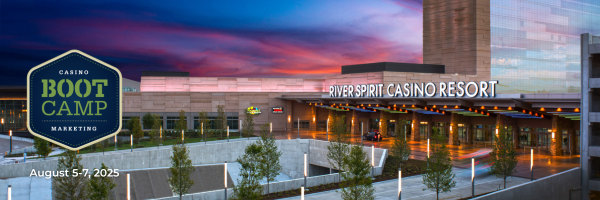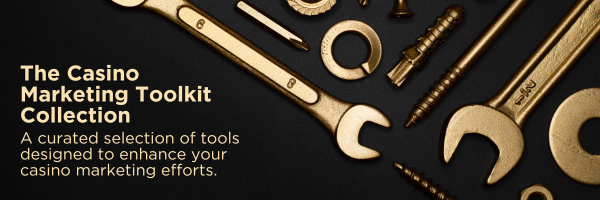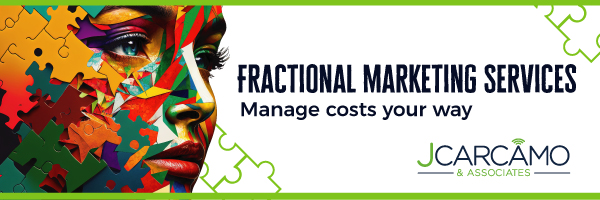The AI Opportunity in Casino Marketing: What’s Real and What’s Next
Only about 25% of casino marketers feel confident in leveraging artificial intelligence.
Picture this: It’s any day of the week. Your casino’s weekend promotion launches in a couple of days. Your database manager is manually segmenting player lists, your advertising coordinator is rushing through email variations, and your GM is questioning whether offers are appropriately tailored. Meanwhile, your competitors are beginning to talk about AI-powered personalization at scale.
This scenario plays out every week across casinos nationwide.
Artificial Intelligence promises to reshape how casinos market, operate, and engage with guests. But while the headlines tout transformation, the reality for regional operators is far more nuanced.
The gap between AI’s potential and practical implementation is vast in our industry, where regulatory frameworks, data integrity and sovereignty concerns, and operational realities create a unique landscape for technology adoption.
Why AI Is a Game-Changer for Player Retention and Casino Growth
There’s no denying the appeal. AI can help marketers:
Predict churn before it happens—identifying at-risk players based on subtle behavioral changes, allowing for proactive retention.
Personalize offers without relying on guesswork—moving beyond basic RFM models to proper one-to-one marketing that considers preferences, play patterns, and engagement history.
Automate repetitive campaign tasks—freeing up to 28% of marketing team time spent on tasks such as reporting and administrative work.
Segment guests more accurately—uncovering player microsegments that traditional analysis might miss.
Create marketing content more efficiently—from property descriptions to promotional emails, AI can help your team write faster and more effectively.
In theory, that means better ROI, more efficient teams, and a more innovative use of reinvestment budgets. Personalized marketing drives a 5–15% lift in revenue and a 10–30% increase in marketing-spend efficiency.
For Marketing Directors: AI tools can help your small team operate like one twice its size, allowing you to execute sophisticated campaigns without additional headcount.
What’s Holding Casinos Back from AI—And How to Move Forward
Despite AI’s potential benefits for casino marketing, adoption in casino operations remains cautious and for good reason. While major commercial properties and corporate chains may have the resources to experiment freely, most casino marketers must balance innovation with real operational constraints.
Let’s address the primary challenges head-on:
Regulatory Compliance
Most tribal and regional casinos operate under strict regulations, from gaming commissions to tribal councils. Any tool that handles customer data must be reviewed not just for what it does but also for how it does it.
Is the AI tool transparent in how it makes decisions?
Does it align with responsible gaming standards?
Can we audit it?
The answers must be crystal clear before implementation.
Data Ownership and Sovereignty
For tribal casinos, data sovereignty is non-negotiable. Any tool that stores or processes player data must operate under the tribe’s terms, not the vendor’s.
This means:
- Owning your data outright
- Avoiding platforms that “train” on your data to improve their broader commercial offering
- Insisting on local hosting or trusted, sovereign-compliant cloud solutions
Internal Readiness
Even the most sophisticated tools are useless if your team isn’t trained or doesn’t trust them. Many casinos, particularly those with smaller marketing departments, don’t have the resources (yet) for deep integration.
For General Managers: The operational reality is that AI adoption must align with your property’s values and community relationships—technology should enhance, not replace, the personal connections your team has built.
Stopping the Silent Loss: How AI Predicts and Prevents Player Churn
If there’s one area where AI can deliver immediate value to casino marketers, it is preventing player churn. The silent erosion of your player base—customers who gradually or suddenly stop visiting—represents one of the most costly challenges in casino marketing today.
For most regional properties, player acquisition costs continue to rise while marketing budgets remain constrained. Every retained player represents thousands in saved marketing dollars and protected revenue. Yet many casinos rely on reactive approaches, only addressing churn after players disengage.
This is precisely where AI’s predictive capabilities shine.
Rather than simply identifying who has already lapsed, artificial intelligence can help you spot who is about to lapse—and why—allowing for timely, personalized interventions that maintain the relationship before it breaks.
Let’s explore how this works, from understanding casino-specific churn patterns to implementing AI-powered retention strategies that preserve player relationships and protect revenue.
For Marketing Directors: Player reactivation campaigns often deliver the highest ROI among all marketing initiatives. AI-powered churn prevention takes this a step further by addressing potential defection before it happens, dramatically improving efficiency for resource-constrained teams.
When implemented thoughtfully, AI-driven churn prevention doesn’t just save players—it transforms your marketing approach from reactive to proactive, from guesswork to precision, and from standardized offers to personalized engagement that players genuinely value.
Understanding Casino Player Churn: What It Looks Like and Why It Happens
Player churn—the gradual or sudden disengagement of once-active players—silently erodes your casino’s revenue base. In most regional markets, reactivating a lapsed player may cost 3-7 times less than acquiring a new one of similar value.
Common patterns of disengagement include:
- Declining visit frequency
- Reduced time on device
- Narrowing game selection
- Decreasing redemption rates
- Lower response to traditional offers
Traditional methods vs. AI-enhanced approaches:
| Traditional Approach | AI-Enhanced Approach |
| Reviews players who haven’t visited in 90+ days | Identifies at-risk players before they become inactive |
| Uses static RFM scoring | Incorporates dynamic behavioral indicators |
| One-size-fits-all reactivation offers | Personalized interventions based on player preferences |
| Periodic big “comeback” campaigns | Continuous micro-interventions at optimal moments |
| Manual list pulls and segmentation | Automated early-warning systems |
How AI Spots At-Risk Players Before They Disengage
AI churn prediction works by analyzing patterns in your player data that human marketers might miss or couldn’t process at scale. The system learns from historical patterns to identify players showing early warning signs of disengagement.
Key data signals that indicate potential defection:
- Subtle changes in visit patterns (not just frequency, but timing and duration)
- Shifts in game preferences or betting patterns
- Declining response rates to certain offer types
- Changes in amenity usage
- Social group dissolution (when players who typically visit together stop doing so)
Here’s a simplified example of how a decision tree algorithm might identify an at-risk player:
- The player historically visits 2-3 times per month
- Last month, visit frequency dropped to once
- Average time on device decreased by 35%
- Points earned per visit declined by 20%
- No restaurant visits (previously averaged one per visit)
- AI conclusion: 78% probability of churn within 60 days
The beauty of machine learning is that it continuously improves its predictions based on outcomes, becoming more accurate over time.
For VPs of Marketing: Predictive churn analytics provide the data-backed wins leadership expects to see, demonstrating marketing’s direct impact on player retention and lifetime value.
From Prediction to Action: How to Build AI-Driven Retention Campaigns
Prediction without action is merely interesting rather than valuable. The true power comes in translating these insights into effective interventions.
Moving from prediction to intervention:
- Segment at-risk players by value tier and churn probability
- Develop targeted reactivation campaigns for each segment
- Test multiple intervention approaches
- Continuously measure effectiveness and refine
Personalization at scale becomes possible when AI helps:
- Determine optimal offer types (F&B vs. Free Play vs. Entertainment)
- Identify ideal timing for outreach
- Select the most effective channels for each player
- Craft messaging that resonates with their specific play patterns
The human touch: When AI should flag for personal outreach. Despite all this automation, sometimes the most effective intervention is a personal call from a host. AI can identify when personal outreach is warranted, particularly for higher-value players showing early signs of disengagement.
Your First Step: Audit your player database to identify how many players went inactive in the past 12 months and calculate the potential revenue recovery from successful reactivation.
Easy AI Wins for Casino Marketers: Start Small, See Big Results
You don’t have to go all-in. Start with low-risk, high-impact applications:
Offer Optimization & Campaign Testing
Use AI to test subject lines, creative, and timing for direct mail or email campaigns. This doesn’t require sensitive data but can significantly improve results.
Copy Assistance & Survey Summaries
AI can help your team write faster, from property descriptions to guest email replies to promotional messages. It can also summarize post-event survey results in seconds.
Anonymized Data Analysis
If you have player tracking, loyalty program usage, or redemption behavior data, AI can help you find patterns without exposing personal information.
Player Segmentation Refinement
Move beyond basic demographic and value-based segmentation to behavior-based microsegments, allowing more precise targeting.
For Marketing Directors: Start by addressing one specific pain point—perhaps offering personalization or email copywriting—to demonstrate quick wins that build team confidence in AI tools.
Your First Step: Identify one repetitive marketing task your team performs weekly that takes significant time but doesn’t require complex decision-making. This is your first AI automation candidate.
Your AI-Ready Marketing Plan: How to Prepare Your Casino for the Future
Before investing in AI tools or platforms, the most successful casino marketers invest in something far more valuable: clarity. Without a structured approach to AI adoption, even the most promising technology can quickly become an expensive distraction rather than a competitive advantage.
For Directors and VPs of Marketing: A well-conceived AI roadmap demonstrates the strategic thinking that executives value, positioning you as a forward-thinking leader who balances innovation with operational pragmatism.
Many casino marketers make the mistake of starting their AI journey by evaluating specific tools or vendors. A more effective approach begins with internal assessment: understanding your data ecosystem, identifying specific business challenges AI could address, and preparing your team and organization for future changes.
Key Components of Your AI Readiness Assessment
A comprehensive AI readiness roadmap addresses four critical areas:
- Data Policies & Governance
Understanding your position on data ownership, regulatory compliance, and current collection practices is the foundation of successful AI implementation.
- Internal Pain Points & Opportunities
Identifying which marketing challenges AI could solve helps prioritize initiatives for maximum impact.
- Team Readiness & Education
Preparing your people for new workflows and building confidence in AI-assisted decision making ensures adoption.
- Vendor Evaluation Framework
Knowing what questions to ask potential AI partners protects your operation and ensures alignment with your needs.
The difference between internal adoption of AI and the use of “AI-powered vendors”
Almost all casino database and marketing vendors now tout “AI-powered” capabilities. There’s an important distinction between:
- Adopting internal AI tools that your team controls and configures
- Working with vendors who use AI as part of their solution
- Determining when each approach makes more sense for your operation
This distinction becomes particularly important when evaluating vendor claims about AI capabilities and determining whether they align with your needs and constraints.
Remember, the goal isn’t to become an AI-powered casino overnight. It’s to thoughtfully integrate AI capabilities that amplify your team’s expertise and enhance the player experience in ways that align with your property’s unique value proposition.
Special Considerations for Tribal and Independent Regional Operators
While all casino operations must approach AI carefully, tribal nations and independent regional operators face distinct considerations that may not be considerations for large commercial operators. Both operate with deeper connections to their local communities and typically lack the corporate resources of major gaming companies.
This connection to place and community is not just a constraint. If approached thoughtfully, it can also be a significant competitive advantage when implementing AI.
For Tribal Operations: Cultural and Governance Considerations
A tribal gaming operation isn’t just a business. It is an extension of community values, governance, and economic self-determination. Any use of AI must reflect that reality.
- Cultural alignment requirements: Technology decisions must respect and reinforce tribal values, not contradict them. This may require additional review processes that commercial operators do not face.
- Governance approval structures: Many tribes have multi-layered approval processes involving gaming commissions, business committees, and tribal councils. AI implementation timelines must account for these governance realities.
- Economic impact responsibility: For many tribes, the casino represents a primary economic engine, funding essential government and community services. Technology decisions carry additional weight when they impact this critical revenue stream.
- Generational perspective: Tribal leaders often make decisions with a multiple-generation view, considering immediate benefits and long-term implications for the community’s data, sovereignty, and cultural integrity.
For All Regional Operators: Community Alignment and Local Control
Independent regional operators—whether tribal or commercial—share important characteristics that influence their AI approach:
- Community integration: Unlike destination resorts or corporate chains, regional casinos serve as community anchors with decades-long relationships. Technology should enhance these connections, not commoditize them.
- Local decision authority: Regional operators typically make decisions locally rather than at a distant corporate headquarters. This allows for more responsive, context-aware implementation but requires broader internal consensus-building.
- Resource constraints: Unlike major commercial operators, regional properties often have leaner IT teams and marketing departments. AI solutions must account for these implementation realities.
- Competitive differentiation: Regional properties compete on relationships and local understanding rather than sheer scale. AI should enhance these differentiators rather than standardize the experience.
Measuring Success: KPIs for Each Role
The KPIs we measure should be specific to the type of operation and our roles. However, the core metrics can be valuable regardless of your role and operation.
Team efficiency metrics
- Time saved on repetitive tasks
- Campaign turnaround time
- Number of tests/variants executed
- Marketing initiatives per team member
Campaign performance indicators
- Response rate improvements
- Conversion rate increases
- Reduction in opt-outs/unsubscribes
- Lift in targeted segment performance
Resource optimization measurements
- Marketing reinvestment ROI
- Promotional expense optimization
- Tool utilization rates
- Cost per player engagement
Revenue impact metrics
- Theoretical and actual win increases
- Player value growth
- Reactivation success rates
- New player acquisition efficiency
Loyalty depth indicators
- Visit frequency improvements
- Cross-amenity utilization
- Program tier progression
- Share of wallet growth
Strategic positioning measurements
- Competitive differentiation
- Brand sentiment improvement
- Market share growth
- New market penetration
Community engagement metrics
- Local event participation
- Social media engagement
- Community feedback sentiment
- Guest satisfaction scores
Operational efficiency indicators
- Database growth and health
- Integration effectiveness
- Data utilization rates
- Cross-departmental collaboration
Competitive differentiation measurements
- Innovation perception
- Player experience uniqueness
- Retention vs. market averages
- Talent attraction and retention
For VPs like Jordan: Focus first on metrics that directly support your growth ambitions and path to GM, particularly those connecting marketing activity to measurable revenue outcomes.
First Step: Choose three KPIs most relevant to your current challenges and establish baseline measurements before implementing AI tools.
The 6-Month Beginner to Integration AI Plan
AI implementation doesn’t have to be overwhelming, expensive, or disruptive to your current operations. The most successful casino marketers approach transformation as a measured journey—a series of intentional steps that build upon each success, rather than a dramatic change
This 6-month roadmap provides a realistic timeline for regional and tribal operators to move from AI curiosity to practical integration. It acknowledges your operational realities: limited resources, competing priorities, and the need to demonstrate value at each stage.
For Marketing Directors: This phased approach allows you to demonstrate quick wins that build internal confidence, making securing resources for broader implementation easier as you progress.
Unlike the all-at-once implementations often promoted by vendors, this plan breaks the process into manageable phases that:
- Minimize disruption to your current marketing operations
- Allow for team adaptation and learning
- Create natural evaluation points
- Deliver incremental value rather than delayed returns
Whether you’re a tribal casino navigating sovereignty considerations or a regional property balancing limited resources, this timeline provides a structured approach that respects your operational context while delivering meaningful results.
Phase 1: Education and assessment (1-2 months)
- Conduct a data readiness audit
- Define specific AI use cases for your property
- Educate key stakeholders on capabilities and limitations
- Establish baseline metrics for future comparison
Phase 2: Small pilot projects (2-3 months)
- Select one low-risk application area
- Implement a limited AI tool trial
- Document process changes and outcomes
- Gather team feedback and address concerns
Phase 3: Evaluation and adjustment (1 month)
- Measure results against baselines
- Identify process improvements
- Address any integration challenges
- Make a go/no-go decision for broader implementation
Phase 4: Broader implementation (3-6 months)
- Expand successful approaches to other applications
- Integrate with existing marketing systems
- Develop team capabilities and confidence
- Begin measuring ROI and business impact
Phase 5: Integration into standard operations (ongoing)
- Make AI tools part of standard workflows
- Continue refining models and approaches
- Identify new opportunity areas
- Share success stories and lessons learned
For Marketing Directors: This phased approach prevents overwhelm and allows your team to build confidence with each success, turning skeptics into champions.
First Step: Identify who will lead your AI assessment initiative and allocate dedicated time for them to research options relevant to your most pressing marketing challenges.
AI Should Support Your Values, Not Compromise Them
AI can be a powerful assistant, but it’s not magic. It should help your team, not replace it, and it must respect your operation’s unique regulatory, cultural, and operational context.
Balancing innovation with operational realities
The most successful AI implementations in casino marketing start with clear business problems, not technology solutions looking for applications. By focusing on specific challenges—player churn, offer personalization, or team efficiency—you create a framework for meaningful adoption.
Maintaining the human element in guest relationships
The casino industry is fundamentally about hospitality and relationships. AI should enhance these connections by freeing your team to spend more time building meaningful guest experiences, not less.
Building a future on your terms, not chasing trends
You don’t need to chase every AI trend. You need to build a future on your own terms that reflects your property’s unique position, community, and values.
The path forward isn’t about having the most advanced technology—it’s about having the right technology that amplifies what already makes your property special.
AI isn’t replacing your expertise—it’s amplifying it, giving you the tools to do more of what matters for your guests, your team, and your community.
🔑 Key Takeaways: How AI Can (Realistically) Support Casino Marketing
1. AI Has Real Potential — But Implementation Must Be Thoughtful
- Only ~25% of casino marketers feel confident using AI tools.
- AI is not a plug-and-play solution in the casino world; it requires careful alignment with regulatory frameworks, data governance, and cultural values — especially in tribal environments.
2. AI Can Dramatically Improve Player Retention
- Churn prediction is one of the most valuable use cases: AI identifies at-risk players before they lapse, enabling personalized, proactive retention strategies.
- Player reactivation costs far less than new acquisition — this makes predictive tools a high-ROI investment.
3. You Don’t Need to Start Big to See Results
- Start with low-risk, high-impact applications like:
- Subject line testing
- Automated segmentation
- Summarizing guest surveys
- Even automating a single repetitive task can demonstrate quick wins and build internal buy-in.
4. Barriers Are Real — But Navigable
- Major blockers include:
- Regulatory compliance (can you audit and explain decisions?)
- Data sovereignty (especially for tribal operations)
- Internal readiness (tools are only as good as the team using them)
5. For Tribal Casinos, Cultural and Governance Alignment Is Essential
- Technology must reflect and support community values.
- Approval timelines, data stewardship, and multigenerational thinking shape AI decisions.
- Sovereignty isn’t a hurdle — it’s an opportunity to build systems that protect long-term tribal interests.
6. AI Should Enhance Relationships, Not Replace Them
- Use AI to free your team for more high-touch, personal service — not less.
- Example: Hosts can be alerted when high-value players are showing early disengagement signs, prompting timely personal outreach.
7. A Phased AI Roadmap Prevents Overwhelm and Builds Confidence
- The 6-month plan includes:
- Education
- Small pilot projects
- Evaluation
- Broader rollout
- Integration into day-to-day marketing
- This approach respects operational realities and maximizes adoption.
8. KPIs Must Reflect Your Goals and Role
- Suggested metrics by category: team efficiency, campaign performance, revenue impact, player loyalty, and strategic differentiation.
- VPs should align AI metrics with broader business outcomes to make a case for leadership.
9. Choose Tools That Amplify What Makes You Unique
- The goal isn’t to become “AI-powered” for the sake of it.
- Choose AI that fits your brand, team size, data policies, and guest experience model.
- AI is a tool — not the strategy.





Comment:
The article highlights the challenges casinos face in adopting AI, especially regional and tribal ones. It’s interesting how regulatory constraints and data sovereignty play such a huge role in slowing down innovation. I wonder if the hesitation is more about the technology itself or the fear of not meeting compliance standards. The emphasis on transparency and auditability is crucial, but it feels like the industry is stuck in a loop of caution. Do you think smaller casinos will ever catch up to the AI advancements of larger chains, or will the gap only widen? Also, how do you see AI balancing personalization with responsible gaming? It’s a fascinating topic, but I’m curious if there’s a middle ground that hasn’t been explored yet. What’s your take on this?
You’re absolutely right to point out the tension between innovation and compliance. In my experience, the hesitation in regional and tribal markets isn’t about distrust in AI itself — it’s about the lack of trust in how AI is implemented, governed, and explained.
For these operators, especially tribal casinos, data sovereignty isn’t just a checkbox — it’s a foundational principle tied to autonomy and long-term economic control. That makes transparency and auditability non-negotiable. If a tool can’t show how it makes decisions or where data is going, it simply won’t (and shouldn’t) make it past the gatekeepers.
As for whether smaller casinos can catch up — I think the answer is yes, but not by copying large operators. The middle ground will come from right-sized, role-specific AI tools that solve targeted problems without requiring full data overhauls or massive investment. Think churn prediction modules, offer testing engines, or even AI-assisted campaign copywriting — all internal, controlled, and practical.
On the personalization vs. responsible gaming front — this is where the industry has a huge opportunity to lead. But the trust we have with guests is paramount and we can’t move without understanding that.
The key is building AI policies as part of your marketing strategy, not bolting them on after the fact. It’s not about catching up to the biggest operators but about moving smartly on your own terms.